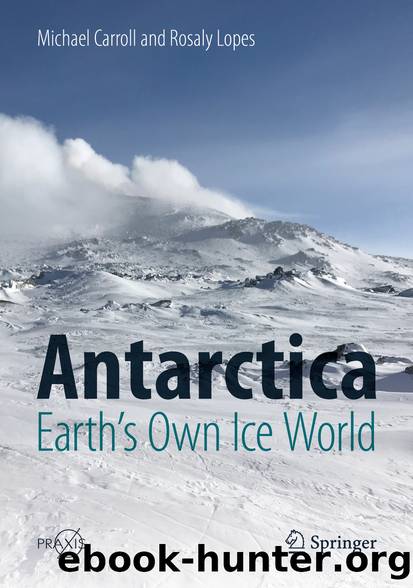Antarctica: Earth's Own Ice World by Michael Carroll & Rosaly Lopes

Author:Michael Carroll & Rosaly Lopes
Language: eng
Format: epub
Publisher: Springer International Publishing, Cham
Fig. 5.3.A Bell 212 helicopter at the Lower Erebus Hut. These aircraft are the primary travel vessels to and from many remote camps, including those in the Dry Valleys (Photo by the authors)
Other teams need to stay for longer periods, either at the main base camp at Lake Hoare or at semi-permanent camps at three other locations. If summer research projects are expected to continue over several seasons at the same location, huts may be erected. These huts, which can be expected to last for several years, provide space, stable working areas, and comfort not achievable with tents. Huts have been used in recent years in Taylor Valley (an ice-free or dry valley in southern Victoria Land) for study of lake ecosystems, at Cape Crozier on Ross Island for population and behavioral studies of penguin rookeries, and near the summit of Mount Erebus for volcanology. Resupply and transport for the Dry Valleys camps happen by helicopter or tracked vehicle from McMurdo Station.
Science teams also erect small tent camps at various locations in the Dry Valleys. Every year, several groups conduct research in this fascinating region. As the name implies, the Dry Valleys are a polar desert, with precipitation (snow) being less than 5 cm a year. During the summer months, glaciers begin to melt, forming small streams that flow into the ice-covered lakes at the bottom of the valley. The Dry Valleys seemed devoid of life to Scott and his team who, in 1903, were the first humans to walk there. The inhospitality of the area left such an impression that they called it “Valleys of the Dead.” Ironically, these days the valleys are one of the prime destinations on Earth for studies of life in extreme environments. There are plankton (a diverse collection of organisms living in water), rotifers (microscopic or near-microscopic animals), tardigrades (water-dwelling, eight-legged, segmented micro-animals), and Archaea (single-cell microorganisms). Algae grows in cryoconite holes, which form when windblown sand grains are deposited on top of the white surface of a glacier. The darker sand grains absorb heat from the sun, causing a small amount of ice to melt and form a pool. Organisms attached to the sand grains can grow and thrive in the water, forming algae. The Dry Valleys are a biologist’s paradise. There are strikingly colorful bacterial mats growing at the bottom of some streams, surprising given that for most of the year there is no water in the streams. The bacterial mats are freeze-dried for months looking like dried sponges but, within 20 minutes of receiving water, they are re-hydrated. Researchers have been able to re-hydrate some mats that had been freeze-dried for over 26,000 years! The survival of these bacterial mats is quite amazing and helps researchers understand how life can survive in harsh conditions on other planets and moons.
The most amazing place in the Dry Valleys – undoubtedly one of the most amazing on the whole continent – is the site of the Blood Falls. The brownish red falls come from Taylor Glacier , the coldest glacier on Earth containing constantly flowing water.
Download
This site does not store any files on its server. We only index and link to content provided by other sites. Please contact the content providers to delete copyright contents if any and email us, we'll remove relevant links or contents immediately.
The Lonely City by Olivia Laing(4568)
Animal Frequency by Melissa Alvarez(4150)
All Creatures Great and Small by James Herriot(3986)
Walking by Henry David Thoreau(3681)
Exit West by Mohsin Hamid(3634)
Origin Story: A Big History of Everything by David Christian(3472)
COSMOS by Carl Sagan(3347)
How to Read Water: Clues and Patterns from Puddles to the Sea (Natural Navigation) by Tristan Gooley(3240)
Hedgerow by John Wright(3106)
How to Do Nothing by Jenny Odell(3102)
The Inner Life of Animals by Peter Wohlleben(3099)
How to Read Nature by Tristan Gooley(3078)
Project Animal Farm: An Accidental Journey into the Secret World of Farming and the Truth About Our Food by Sonia Faruqi(3018)
Origin Story by David Christian(2991)
Water by Ian Miller(2950)
A Forest Journey by John Perlin(2915)
The Plant Messiah by Carlos Magdalena(2745)
A Wilder Time by William E. Glassley(2690)
Forests: A Very Short Introduction by Jaboury Ghazoul(2671)
